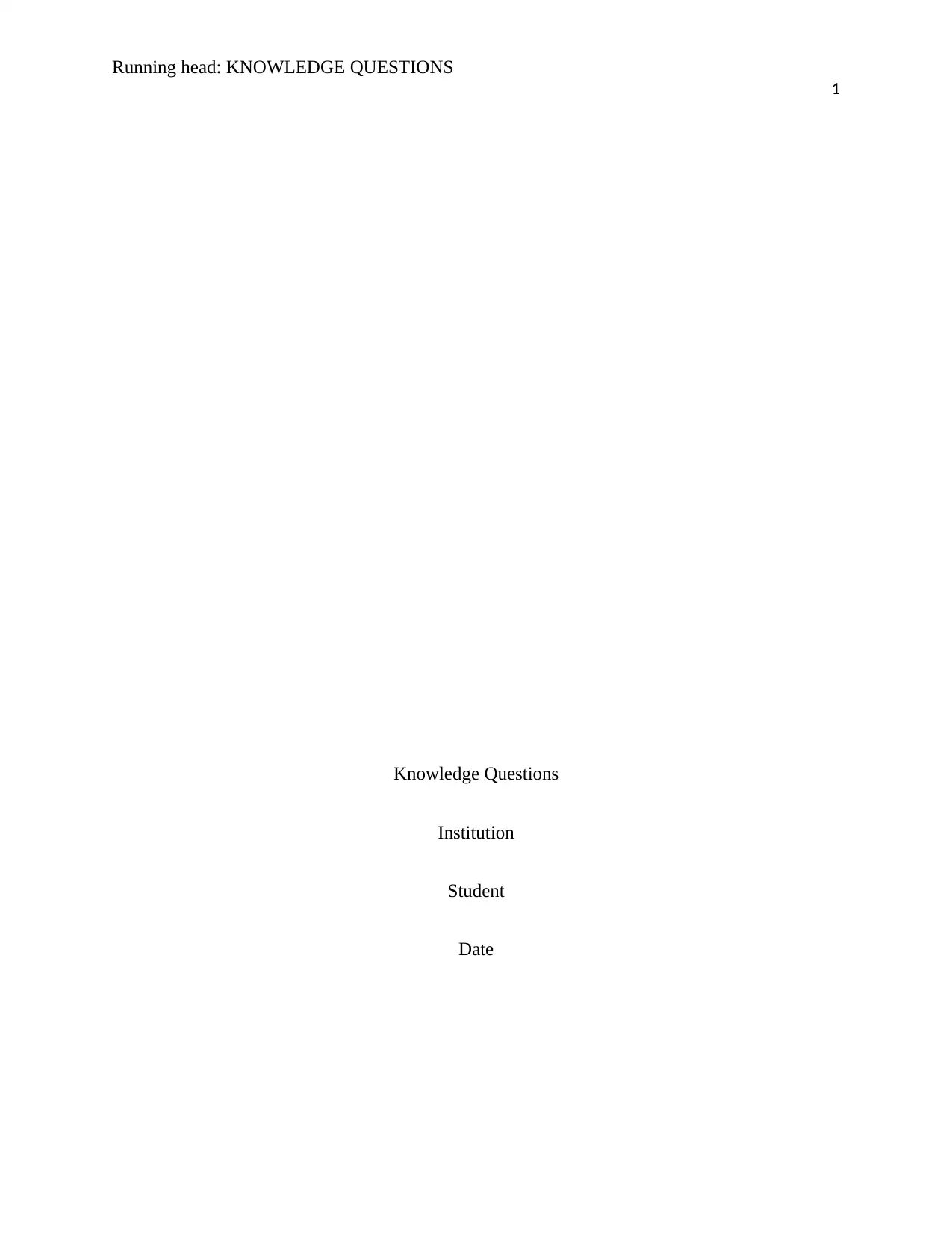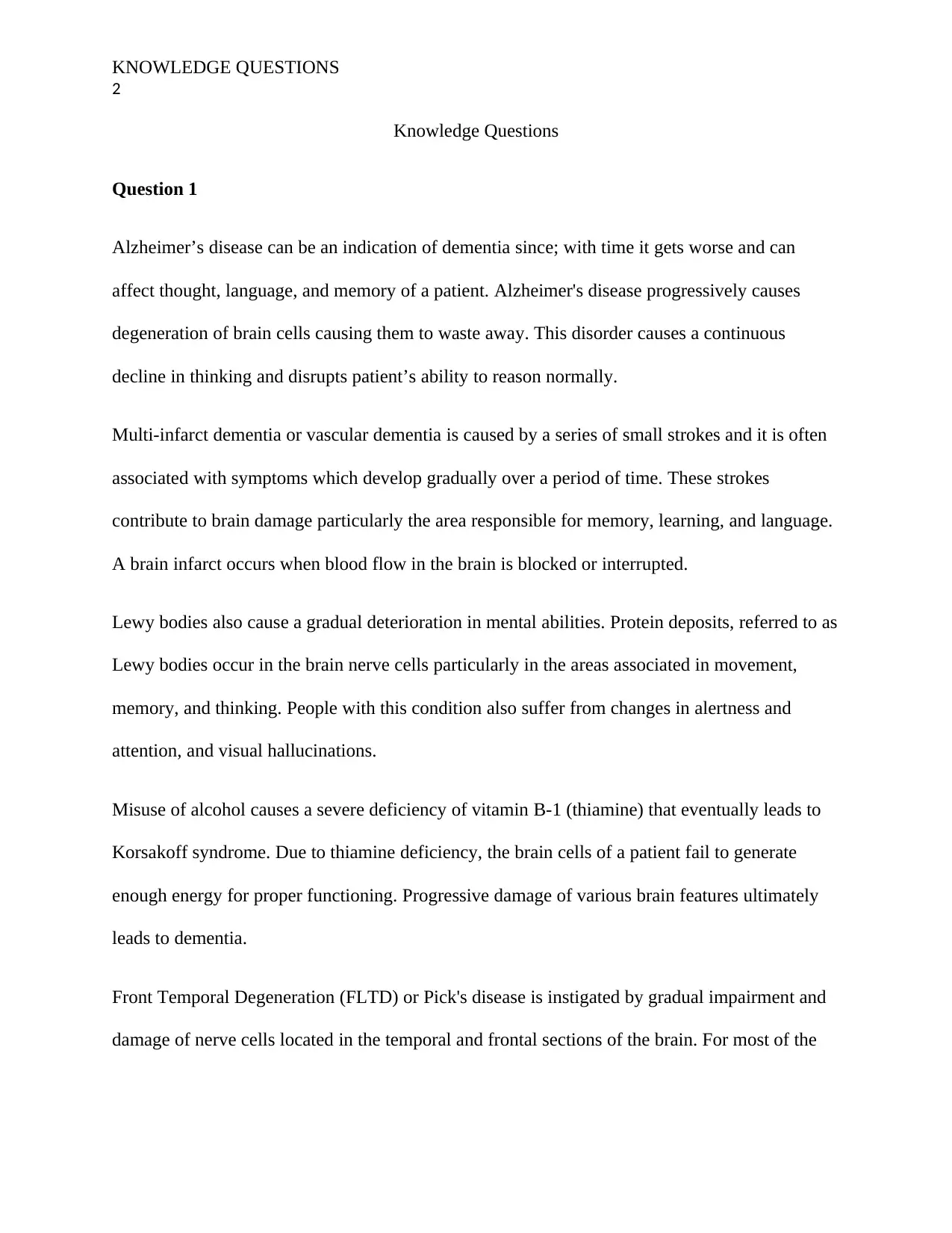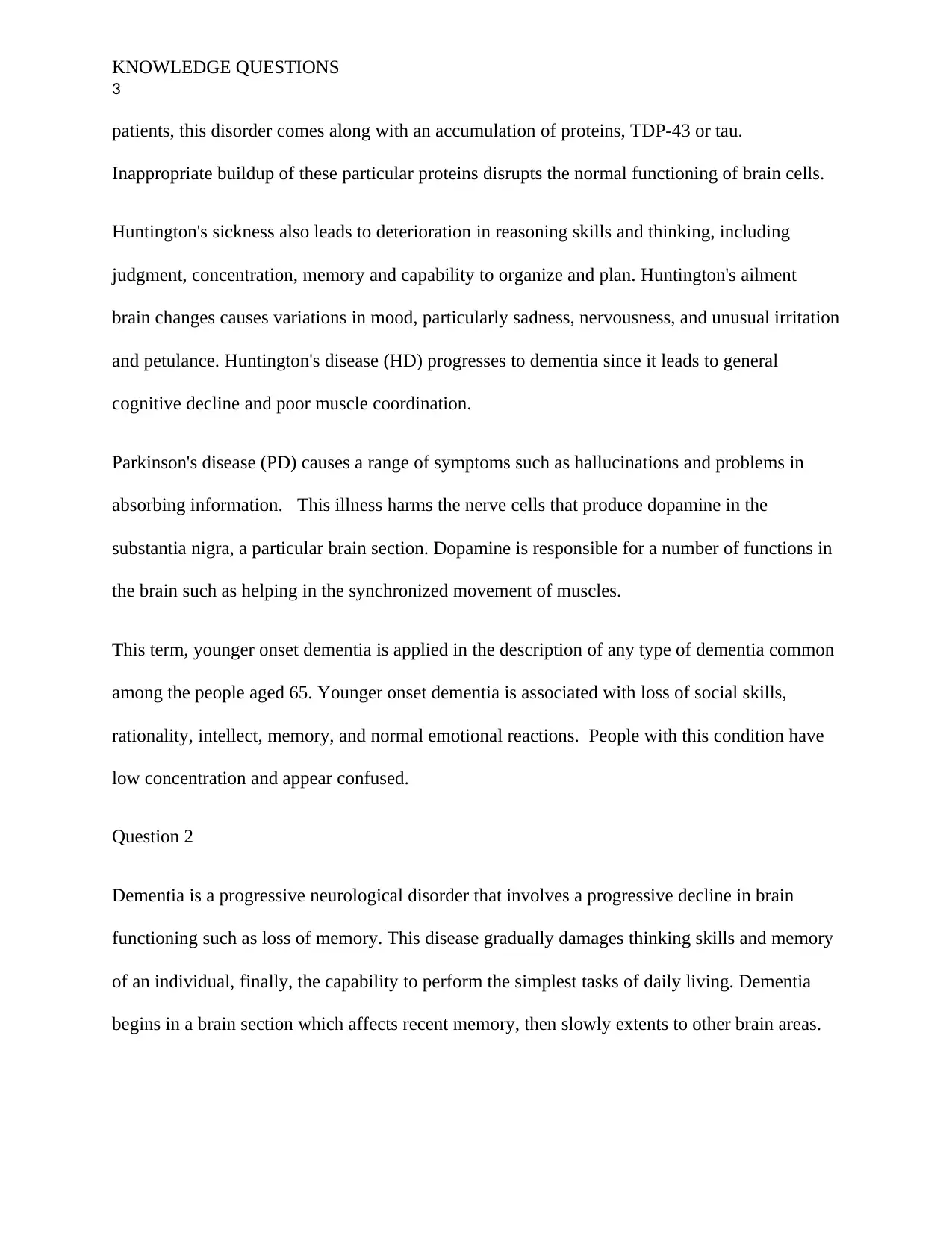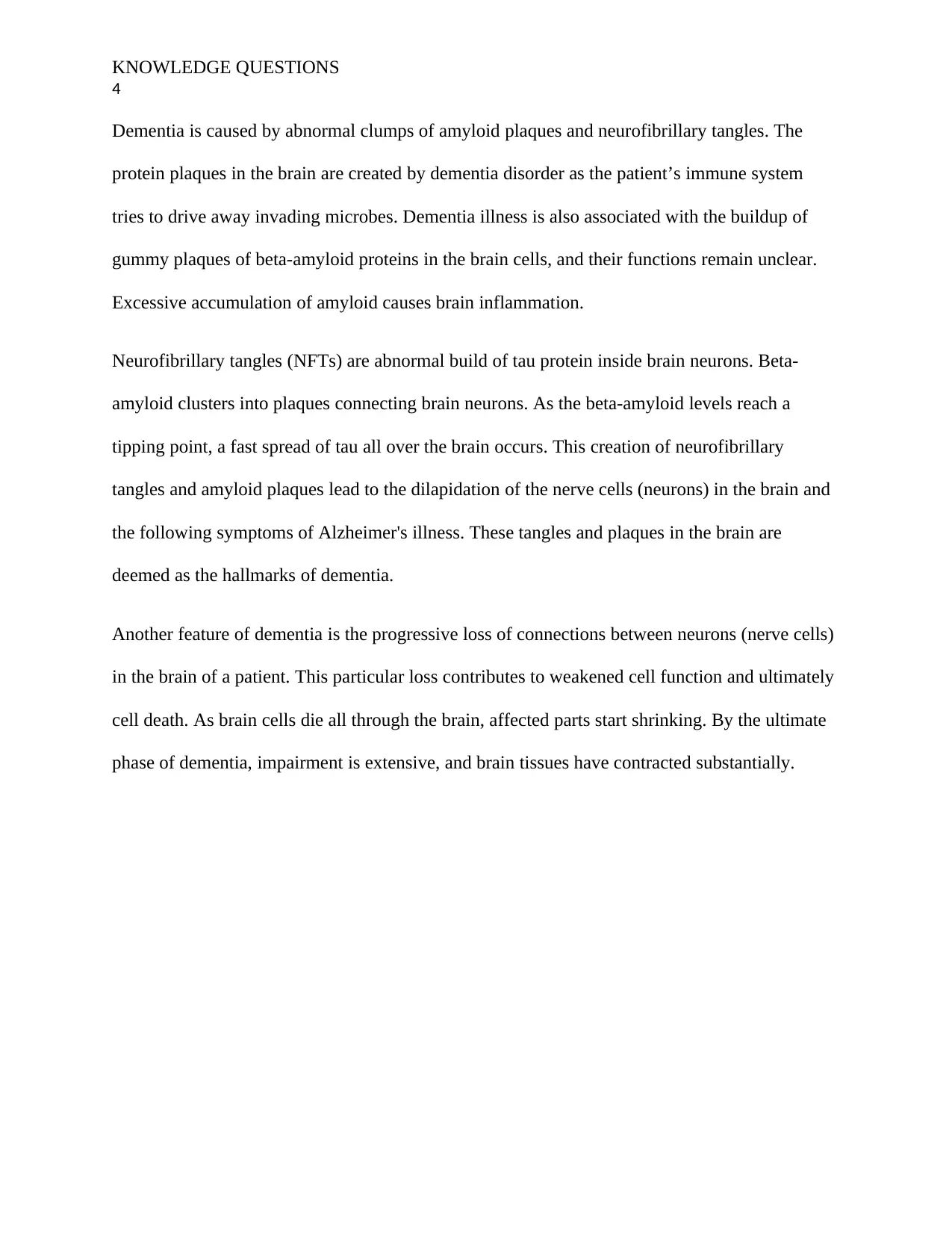Exploring Dementia: Knowledge Questions on Alzheimer's Disease
VerifiedAdded on 2022/09/18
|4
|792
|23
Homework Assignment
AI Summary
This assignment addresses key knowledge questions related to dementia and Alzheimer's disease. It explains how Alzheimer's disease, multi-infarct dementia, Lewy body dementia, alcohol-related Korsakoff syndrome, frontotemporal degeneration, Huntington's disease, and Parkinson's disease can lead to dementia. The assignment further discusses the progressive nature of dementia, highlighting the role of amyloid plaques and neurofibrillary tangles in the brain. It also explains how these factors contribute to the loss of connections between neurons, leading to brain shrinkage and cognitive decline. The document emphasizes the importance of understanding the underlying mechanisms of dementia to better address and manage the condition. Desklib offers additional resources and solved assignments for further study.

Running head: KNOWLEDGE QUESTIONS
1
Knowledge Questions
Institution
Student
Date
1
Knowledge Questions
Institution
Student
Date
Paraphrase This Document
Need a fresh take? Get an instant paraphrase of this document with our AI Paraphraser

KNOWLEDGE QUESTIONS
2
Knowledge Questions
Question 1
Alzheimer’s disease can be an indication of dementia since; with time it gets worse and can
affect thought, language, and memory of a patient. Alzheimer's disease progressively causes
degeneration of brain cells causing them to waste away. This disorder causes a continuous
decline in thinking and disrupts patient’s ability to reason normally.
Multi-infarct dementia or vascular dementia is caused by a series of small strokes and it is often
associated with symptoms which develop gradually over a period of time. These strokes
contribute to brain damage particularly the area responsible for memory, learning, and language.
A brain infarct occurs when blood flow in the brain is blocked or interrupted.
Lewy bodies also cause a gradual deterioration in mental abilities. Protein deposits, referred to as
Lewy bodies occur in the brain nerve cells particularly in the areas associated in movement,
memory, and thinking. People with this condition also suffer from changes in alertness and
attention, and visual hallucinations.
Misuse of alcohol causes a severe deficiency of vitamin B-1 (thiamine) that eventually leads to
Korsakoff syndrome. Due to thiamine deficiency, the brain cells of a patient fail to generate
enough energy for proper functioning. Progressive damage of various brain features ultimately
leads to dementia.
Front Temporal Degeneration (FLTD) or Pick's disease is instigated by gradual impairment and
damage of nerve cells located in the temporal and frontal sections of the brain. For most of the
2
Knowledge Questions
Question 1
Alzheimer’s disease can be an indication of dementia since; with time it gets worse and can
affect thought, language, and memory of a patient. Alzheimer's disease progressively causes
degeneration of brain cells causing them to waste away. This disorder causes a continuous
decline in thinking and disrupts patient’s ability to reason normally.
Multi-infarct dementia or vascular dementia is caused by a series of small strokes and it is often
associated with symptoms which develop gradually over a period of time. These strokes
contribute to brain damage particularly the area responsible for memory, learning, and language.
A brain infarct occurs when blood flow in the brain is blocked or interrupted.
Lewy bodies also cause a gradual deterioration in mental abilities. Protein deposits, referred to as
Lewy bodies occur in the brain nerve cells particularly in the areas associated in movement,
memory, and thinking. People with this condition also suffer from changes in alertness and
attention, and visual hallucinations.
Misuse of alcohol causes a severe deficiency of vitamin B-1 (thiamine) that eventually leads to
Korsakoff syndrome. Due to thiamine deficiency, the brain cells of a patient fail to generate
enough energy for proper functioning. Progressive damage of various brain features ultimately
leads to dementia.
Front Temporal Degeneration (FLTD) or Pick's disease is instigated by gradual impairment and
damage of nerve cells located in the temporal and frontal sections of the brain. For most of the

KNOWLEDGE QUESTIONS
3
patients, this disorder comes along with an accumulation of proteins, TDP-43 or tau.
Inappropriate buildup of these particular proteins disrupts the normal functioning of brain cells.
Huntington's sickness also leads to deterioration in reasoning skills and thinking, including
judgment, concentration, memory and capability to organize and plan. Huntington's ailment
brain changes causes variations in mood, particularly sadness, nervousness, and unusual irritation
and petulance. Huntington's disease (HD) progresses to dementia since it leads to general
cognitive decline and poor muscle coordination.
Parkinson's disease (PD) causes a range of symptoms such as hallucinations and problems in
absorbing information. This illness harms the nerve cells that produce dopamine in the
substantia nigra, a particular brain section. Dopamine is responsible for a number of functions in
the brain such as helping in the synchronized movement of muscles.
This term, younger onset dementia is applied in the description of any type of dementia common
among the people aged 65. Younger onset dementia is associated with loss of social skills,
rationality, intellect, memory, and normal emotional reactions. People with this condition have
low concentration and appear confused.
Question 2
Dementia is a progressive neurological disorder that involves a progressive decline in brain
functioning such as loss of memory. This disease gradually damages thinking skills and memory
of an individual, finally, the capability to perform the simplest tasks of daily living. Dementia
begins in a brain section which affects recent memory, then slowly extents to other brain areas.
3
patients, this disorder comes along with an accumulation of proteins, TDP-43 or tau.
Inappropriate buildup of these particular proteins disrupts the normal functioning of brain cells.
Huntington's sickness also leads to deterioration in reasoning skills and thinking, including
judgment, concentration, memory and capability to organize and plan. Huntington's ailment
brain changes causes variations in mood, particularly sadness, nervousness, and unusual irritation
and petulance. Huntington's disease (HD) progresses to dementia since it leads to general
cognitive decline and poor muscle coordination.
Parkinson's disease (PD) causes a range of symptoms such as hallucinations and problems in
absorbing information. This illness harms the nerve cells that produce dopamine in the
substantia nigra, a particular brain section. Dopamine is responsible for a number of functions in
the brain such as helping in the synchronized movement of muscles.
This term, younger onset dementia is applied in the description of any type of dementia common
among the people aged 65. Younger onset dementia is associated with loss of social skills,
rationality, intellect, memory, and normal emotional reactions. People with this condition have
low concentration and appear confused.
Question 2
Dementia is a progressive neurological disorder that involves a progressive decline in brain
functioning such as loss of memory. This disease gradually damages thinking skills and memory
of an individual, finally, the capability to perform the simplest tasks of daily living. Dementia
begins in a brain section which affects recent memory, then slowly extents to other brain areas.
⊘ This is a preview!⊘
Do you want full access?
Subscribe today to unlock all pages.

Trusted by 1+ million students worldwide

KNOWLEDGE QUESTIONS
4
Dementia is caused by abnormal clumps of amyloid plaques and neurofibrillary tangles. The
protein plaques in the brain are created by dementia disorder as the patient’s immune system
tries to drive away invading microbes. Dementia illness is also associated with the buildup of
gummy plaques of beta-amyloid proteins in the brain cells, and their functions remain unclear.
Excessive accumulation of amyloid causes brain inflammation.
Neurofibrillary tangles (NFTs) are abnormal build of tau protein inside brain neurons. Beta-
amyloid clusters into plaques connecting brain neurons. As the beta-amyloid levels reach a
tipping point, a fast spread of tau all over the brain occurs. This creation of neurofibrillary
tangles and amyloid plaques lead to the dilapidation of the nerve cells (neurons) in the brain and
the following symptoms of Alzheimer's illness. These tangles and plaques in the brain are
deemed as the hallmarks of dementia.
Another feature of dementia is the progressive loss of connections between neurons (nerve cells)
in the brain of a patient. This particular loss contributes to weakened cell function and ultimately
cell death. As brain cells die all through the brain, affected parts start shrinking. By the ultimate
phase of dementia, impairment is extensive, and brain tissues have contracted substantially.
4
Dementia is caused by abnormal clumps of amyloid plaques and neurofibrillary tangles. The
protein plaques in the brain are created by dementia disorder as the patient’s immune system
tries to drive away invading microbes. Dementia illness is also associated with the buildup of
gummy plaques of beta-amyloid proteins in the brain cells, and their functions remain unclear.
Excessive accumulation of amyloid causes brain inflammation.
Neurofibrillary tangles (NFTs) are abnormal build of tau protein inside brain neurons. Beta-
amyloid clusters into plaques connecting brain neurons. As the beta-amyloid levels reach a
tipping point, a fast spread of tau all over the brain occurs. This creation of neurofibrillary
tangles and amyloid plaques lead to the dilapidation of the nerve cells (neurons) in the brain and
the following symptoms of Alzheimer's illness. These tangles and plaques in the brain are
deemed as the hallmarks of dementia.
Another feature of dementia is the progressive loss of connections between neurons (nerve cells)
in the brain of a patient. This particular loss contributes to weakened cell function and ultimately
cell death. As brain cells die all through the brain, affected parts start shrinking. By the ultimate
phase of dementia, impairment is extensive, and brain tissues have contracted substantially.
1 out of 4
Related Documents
Your All-in-One AI-Powered Toolkit for Academic Success.
+13062052269
info@desklib.com
Available 24*7 on WhatsApp / Email
![[object Object]](/_next/static/media/star-bottom.7253800d.svg)
Unlock your academic potential
Copyright © 2020–2025 A2Z Services. All Rights Reserved. Developed and managed by ZUCOL.





